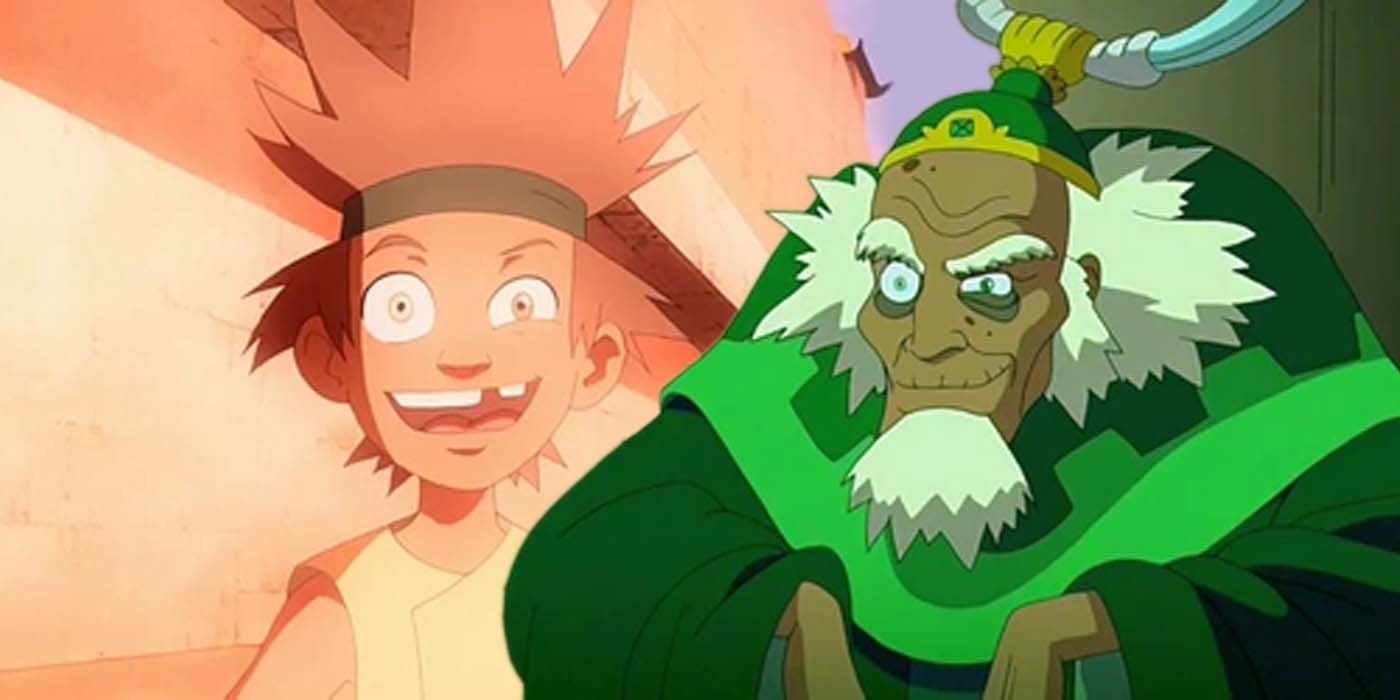
How Bumi Became King Of Omashu In Avatar: The Last Airbender
Within the continuity of Avatar: The Last Airbender, King Bumi’s ascension to the throne of Omashu is never fully explained, but there are several popular fan theories that suggest how it happened. Upon his first appearance in the show as Avatar Aang’s childhood best friend, it initially comes as a surprise that Bumi is revealed to be the King of the Earth Kingdom city Omashu in the story’s present day. Although the manner of exactly how he became king is shrouded in mystery, there are enough hints within the meta that many of the fan theories make a great deal of sense.
In Avatar: The Last Airbender season 1, episode 5 “The King Of Omashu,” Aang, Katara, and Sokka travel to the city of Omashu, the home of Aang’s old friend, Bumi. Aang begins to reminisce about the good times he spent with his friend, which is shown in the form of a short flashback scene of the two sliding down the city’s delivery system chutes. Aang and company come face to face with the King of Omashu, who then learns of Aang’s status as the Avatar and proceeds to force the young airbender to undergo a series of challenges. He must complete the tasks in order to save his friends, who the King is holding hostage. After completing said challenges, Aang is shocked to discover that the King is none other than Bumi himself. While Bumi has aged significantly in the many years that Aang was absent, he is still the same mad genius that Aang so fondly remembers.
One major arc within the show’s universe is the fact that Aang was once previously frozen in ice for one hundred years. With Aang gone for so long, the world that he returned to was extremely different, and Bumi becoming King was just one of the huge changes that Aang had to discover in his travels. Although the show does not elaborate on exactly how Bumi was crowned in the first place, that has not stopped Avatar: The Last Airbender fans from making educated guesses.
Bumi Was Born As A Noble/Royal

One common aspect of royalty is that, more often than not, one must be born with such a status. In the city of Ba Sing Se, the capital of the Earth Kingdom, Aang and his friends meet the Earth King and in The Legend of Korra, the throne is passed down a generational line. As Bumi became the King of Omashu, it would make sense that he is a member of a royal family within the Earth Kingdom, or at the very least is part of a noble one, much like Toph Beifong and her family. However, the flashback of him as a child seemingly contradicts this idea. In this scene, Bumi is dressed in ragged clothes and does not appear to be a noble.
While this image could disprove this theory, there are several accounts within both history and fiction that there have been some members of royalty who have donned different clothes in order to mingle among the populace without being noticed. Considering Bumi’s typical behavior and fondness for all things unorthodox, it is actually possible that Bumi himself could have dressed in street clothes as a means of disguise whenever he went out to play with his friends. Either that, or his fancier robes and attire are simply not his style in the first place and his puckish nature and wild stunts made the rougher garb more fitting.
Bumi Became An Heir To The Omashu Throne

There is another theory that alludes to the fact that Bumi is an incredibly powerful earthbender in Avatar: The Last Airbender, and that it is these very skills that earn him the throne of Omashu. This theory suggests that Bumi is not a noble, but is actually a commoner that caught the eye of the previous King of Omashu. This would explain his clothing and appearance in the flashback, as it seems that such an occurrence has yet to take place. The theory goes on to suggest that the then King did not have any children of his own and after hearing about Bumi’s skill, the King took him in and mentored him so that he may one day take his place on the throne of Omashu as his heir. Over the years, Bumi would have continued to impress the King of Omashu with his earthbending technique and alternative way of thinking, which would have cemented his place as a wise and mighty ruler. This theory is also often coupled with another theory that is fairly similar, except in that one, the King marries Bumi’s mother and he is made a prince and heir as a result of the marriage.
Bumi Rebelled Against The Omashu Monarchy

One last theory derives itself from the many real-world allusions that are present throughout the show. It is relatively common knowledge that the show’s creators, Michael Dante DiMartino and Bryan Konietzko, took every nation within Avatar: The Last Airbender and loosely modeled them after certain civilizations and cultures. The Air Nomads are a reference to the Buddhist monks of Tibet, the Fire Nation is based on Imperial Japan, the Water Tribes allude to arctic cultures like the Inuit people, and the Earth Kingdom (which the city of Omashu is a part of) is inspired by Dynastic China. During the age of Dynastic China, dynasties are created when a rebellion takes place, and a new family line overthrows the previous reigning family. This theory builds its foundation on this particular historical fact.
The theory suggests that Bumi does in fact come from the common folk, but seemingly grows up during a time when the Omashu monarchy is already taken over by the Fire Nation. When he becomes a young man, Bumi either leads or takes part in a city-wide rebellion against the throne, which results in the toppling of the Fire Nation reign over Omashu and the freedom of the city’s inhabitants. Due to his fighting prowess and skills as a leader (not to mention the army of Omashu citizens at his back), Bumi is selected to be placed on the throne to rule as the new King. This interesting Avatar: The Last Airbender theory is inspired heavily by the true story about Hongwu, the founding emperor of China’s Ming Dynasty, who experienced a similar set of events that led him to become emperor and put an end to the Yuan Dynasty.



























































